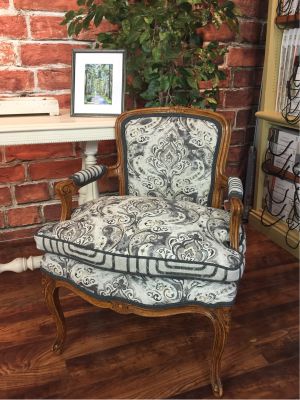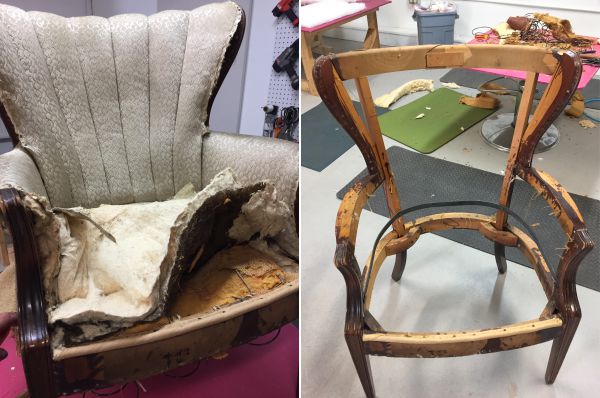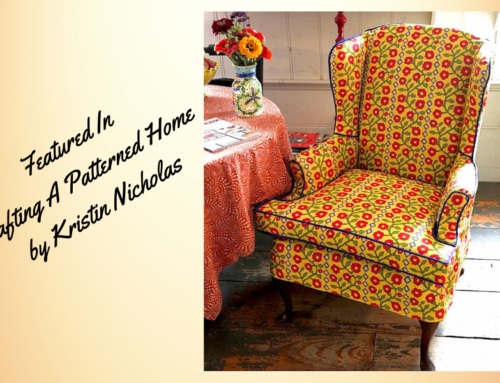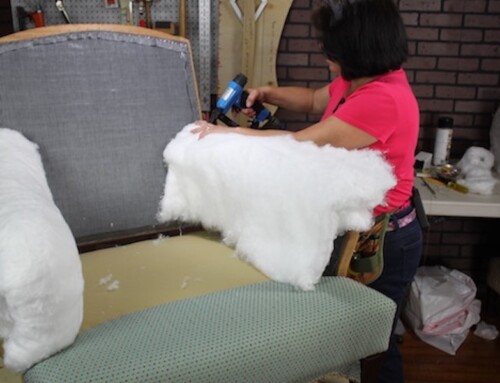
You have a chair you want reupholstered. Your first step was to call a local furniture upholsterer and ask “How much does it cost to reupholster a chair?”
The response you received might not have been what you expected. The number was higher than you thought it would be.
That lead to even more questions: What does the price really include? Is my chair actually worth the effort? What is involved in reupholstering a chair anyway? Should I try and do it myself?
Of course the best way to answer these questions is to do your research and ask your local upholsterer for more information. But I will try and answer these common questions here.
When an upholsterer gives me a quote for the cost for reupholstering a chair, what is included?
Let’s for example say the upholsterer quoted you $1500 to reupholster your chair. The breakdown of the cost might look something like this:
- Fabric: $500 to $700 depending on the quality and price per yard
- New padding and supplies: $100 to $200
- Labor: $700 to $800 in labor includes tear down, minor frame repair, adding new support systems and retying springs and finally adding padding and fabric.
Is it worth the effort and cost to reupholster?

Reupholstering furniture is a great, environmentally friendly way to keep old furniture out of landfills. However, it is not always the most inexpensive choice. The truth is that reupholstering furniture can often cost as much as replacing it (and sometimes more).
For example, the cost to reupholster a chair cushion may be less than $150, and it’s unlikely you can replace the entire chair for that amount. On the other hand, repairing and re-padding the same chair can raise the price more than $1,100 to $1,500. In that case, you need to decide whether it’s simpler and cheaper to simply purchase an entirely new chair.
Here are some things to think about when deciding if it’s worth the cost to reupholster your chair:
- How old is the chair? Has it been regularly used? If it has lasted many years, chances are it is well made and sturdy enough to last.
- Is the frame solid, sturdy, and made from hardwood? When building high-quality furniture, manufacturers use hardwood for the frame and attach the joints using dowels and glue or screws. Inexpensive furniture usually has engineered wood and staples for the joints.
- How much do you truly like the piece? If you love the style and cannot find a similar piece in a store, reupholstering is the way to go.
- Is it a sentimental piece, or a family heirloom? You may just want to bring it back to life no matter what.
- For more information about evaluating your chair and making a decision, check out my blog post on Upholstery DIY Flea Market Finds.
It is important to note here that there is a big difference between reupholstering furniture and simply recovering it.
Recovering vs Reupholstering Furniture: What Is The Difference?
Learning how to reupholster furniture means learning all the steps…not just shortcuts
Recovering furniture refers simply to the process of removing the old fabric and putting on new fabric. But leaving the old padding not doing anything else. More on this later..
Reupholstering furniture includes a complete tear down of the piece, removing all fabric, padding, and the support systems. This process ensures the end product not only looks better, but really is better. Once completed you have a brand new piece that is clean inside and out, and is ready for many more years of enjoyment.
Reupholstering My Chair: Can I Do It Myself?
Be prepared with the right tools for the job
The best way to get started learning how to reupholster is to have the right tools for the job. If you are going to reupholster more than one piece (I am willing to bet the upholstery addiction will hook you and you will do more than one) having the right tools will be well worth the cost.
You can check out my blog post about the right tool for the job for my suggested upholstery tools. And don’t forget to download your FREE PDF on tools.
Related articles you may enjoy:
- Do You Want To Learn How To Upholster Furniture?
- Upholstery, Can I Really Do This?
- 5 Secrets for Creating a Successful Upholstery Business
Purchasing a little extra fabric to reupholster your chair is like buying insurance
Now that you have decide that your chair is a worthy candidate for reupholstery, you need to know how to measure your chair so you can buy the right amount of fabric (fabric yardages). In our online upholstery classes membership we have a video that will help you with this task.
Because you are new to upholstery, I would suggest you purchase two or three extra yards fabric. It is better to have extra than to run short because you made a bad cut. Imagine you need to recut a piece of fabric and now your fabric is no longer available for sale! It happens.
Tear Down: Yes, I did just say epidermis. Gross!
Tear down is the first step and it is a DIRTY job. Not sure why reupholstering furniture has never made it on the show “Dirty Jobs with Mike Rowe”, but it should have! Check out this video that we have created on Wingback Chair Teardown to help you get started.
Remember when I mentioned Reupholster vs Recover? Recovering an upholstered piece is what I consider a short cut. And as is true with most short cuts, they will come back to haunt you. As you watched the video showing you the teardown process, did you notice how nasty everything underneath the fabric was? Gross! Who wants to put all this effort and money into a chair and have all that filth left in the old padding.
I think of this not just as dust and dirt… but epidermis. Ewww! Remember, the dust you remove when you polish the wooden surfaces in your home are also filtering down through the fabrics of your upholstery.
Upholstery tear down is a dirty job, but necessary in the process of reupholstering a chair

Yes, the old padding is nasty and dirty, but that is not the only problem with taking a shortcut and only recovering and not reupholstering. When you watched the tear down you saw what else we found when we removed all the padding.
The support systems were shot. So think about this: You purchased and put on your beautiful new fabric – which was not inexpensive – and you left the old padding (gross). But that also means you didn’t have a way to see what was happening to the support underneath all of that.
So now you’ve got your new fabric on your not so clean chair and 2 years down the road you go to sit in your chair and that old, worn out support system lets go. Oh no! Now your butt is falling through the bottom and you are really annoyed that you took that short cut.
Take lots of pictures and notes. It will benefit you when it’s time to put it all back together.
As you tear down your chair take notes and lots of pictures. You will also want to take notice of what materials and supplies were in your chair. Traditional methods use fibers and horse hair for padding. But with more modern techniques you can accomplish a comfortable piece using upholstery cotton and Dacron.
For your support system you will need Jute webbing or Synthetic Sagless. You may find coil springs in your piece and typically they can be saved to reuse unless you find them to be broken. Zig zag springs are another item you may find that can be reused. But everything else will need to go.
Purchasing new burlap, edge roll, jute webbing, etc, is not all that costly. You can probably buy all the items you need, even one roll of upholstery cotton – but not including foam – for less than $70. Well worth the expense considering the time and effort invested and the new fabric you purchased.
The cost to reupholster a chair has new meaning!
If you are trying to decide if you can do it yourself (I believe in you!), I hope at this point you have a clearer understanding of what is involved.
If you decide to hire a professional upholsterer and ask “How much does it cost to reupholster a chair?” now you have a better understanding of what is included in the process. No the upholsterer was not crazy, or trying to rip you off.
Reupholstering furniture the right way takes time and skill, and it is not to be taken lightly. Recovering furniture is, IMHO not completely up to par. It does cost less to have that type of work done, but which way do you want to go now that you are informed?
I encourage you to learn the whole job and over time you will have the knowledge and skills to reupholster furniture for friends, family and even clients. Learn the right way and you will have pieces that will give you years of enjoyment.
I should warn you, your friends will want you doing their upholstery projects too and you may find yourself working from home in your new upholstery business!
Share, Learn, Collaborate and Network with a community that understands
Each member of our growing community of DIYers and Upholstery Entrepreneurs started out just like you. Many took on that one chair as a hobby and have now found an unavoidable addiction and love of upholstery.
Some are now thriving in business, reupholstering for clients and flipping furniture and recycled pieces. Whichever way you go, please know that we have your back. Our community has become a great place to share, learn, collaborate and network with others just like you!
I can’t wait to see how your chair turns out. Please share your progress in the community should you decide to join in on the fun!
Thanks for reading,




